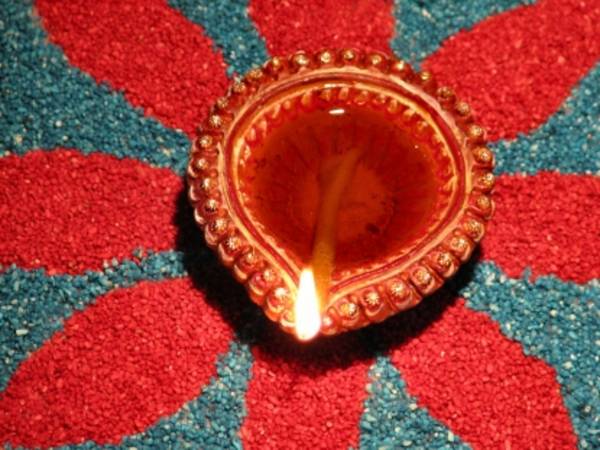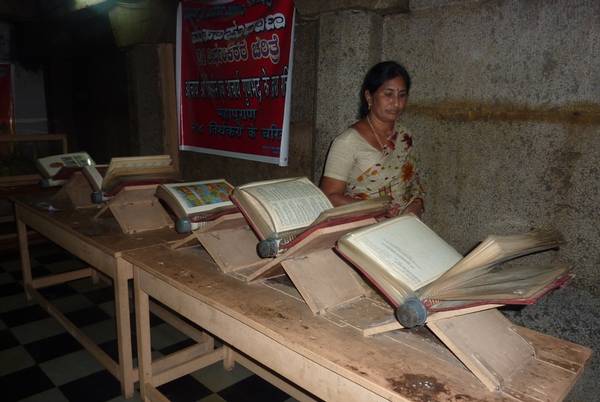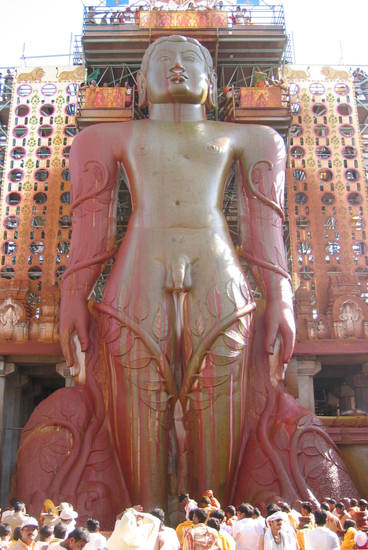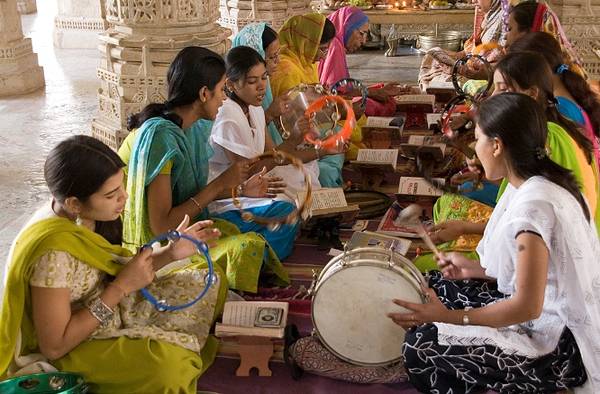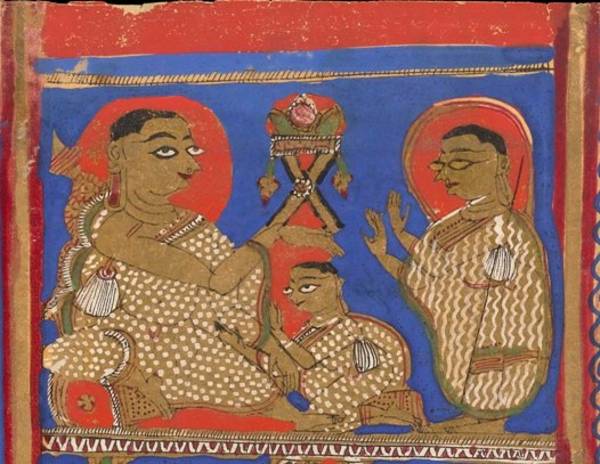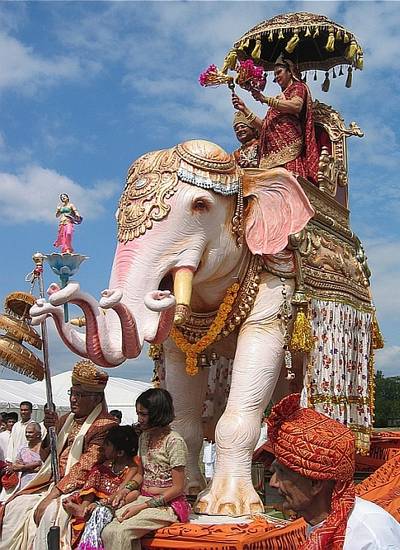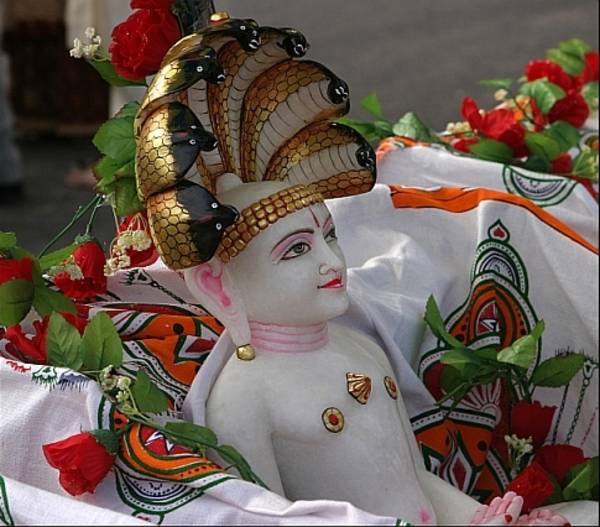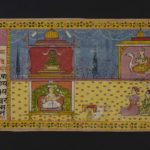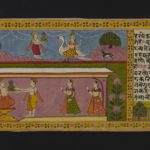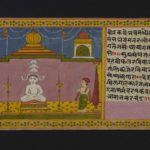Article: Festivals
Jain festivals are public statements of the beliefs of the Jains and their identity as a community. There are various types of Jains – Digambaras and Śvetāmbaras, for instance – so festivals are sometimes common to all Jains, sometimes specific to one sect or local group. There are around seven major festivals each year as well as local celebrations.
During festivals the various elements of the Jain community of monks, nuns and lay people have closer contact than normal. As well as encouraging religious observance among the laity, particularly fasting, it also aids the transmission of religious principles and practices. The cohesion of the lay community may well be strengthened and faith refreshed.
In addition to the social aspects of participating in key community occasions, lay Jains can make spiritual progress by attending festivals. They can gain merit – puṇya – to lessen the karmic matter stuck to the soul and improve their spiritual purity. This aids them in the ultimate goal of liberation from the cycle of rebirth. Many Jains also believe that taking part in festivals may help them in this world, in matters such as health, finances and good luck.
Governed by the lunar calendar, Jain festivals are all joyful celebrations, never commemorating sad events. The main Jain festivals tend to focus on events in the lives of the Jinas and other holy figures and on basic concepts of belief. Other public celebrations are inspired by local events, whether at the neighbourhood temple or connected with the mendicant community.
Knowledge of the sacred teachings is a key part of the Jain faith. During festivals techniques of preaching, story-telling, acting, art and music are employed to pass on beliefs and practices.
The religious dimensions of the majority of Jain festivals are clear, but so too is the public rejoicing at the heart of these events. Colourful processions, music and hymn-singing are the most visible parts of Jain festivals for outsiders.
Donations to temples are frequently made on festival days because donors gain greater karmic merit if they give at these times. Often, numerical symbolism guides procedures during a given festival, determining the number of fasts, the number of objects to be used and so on. For instance, five is a crucial number in Jñāna-pañcamī, ten in Daśa-lakṣaṇa-parvan.
Festival traditions help pass on core principles and practices, strengthening the sense of continuity and shared experience. Jains have always been a small minority in India so a powerful community spirit helps to ensure the survival of the faith and the presentation of a strong identity to outsiders.
Why Jains have festivals
In the Jain context festivals are significant in several religious and social respects, particularly as they have developed in a society where Jains form a very small minority. Involving all members in a district, lay and ascetic, festivals are occasions for reinforcing religious principles and practices, consolidating bonds among the local and wider community and presenting the Jain community to non-Jains. Religious festivals are always celebrations for Jains, never commemorations of sad events.
Jains commonly use various terms for ‘festival’, each of which captures a different aspect of the event.
From the Sanskrit parvan, parv refers to calendar terminology and indicates a change in the moon. This highlights the connection between the lunar calendar and the dates of festivals. More broadly, it refers to a holy day, like its synonym parvitithi.
The term vrata means the vow, commitment or religious observances that Jains make voluntarily on special occasions or for certain periods of time. Many lay Jains undertake a vow during a festival, frequently a type of fasting.
The words ut-sava and mahot-sava underline the idea of public celebration.
The word ‘festival’ can be understood as a term for public celebrations that take place annually or periodically on fixed dates. But there are also other festivals that are public events of equal importance for lay Jains. The most important commemorate notable events in the local temple and in the lives of local mendicants.
For most Jains the inauguration of a new temple or the installation of a new image in a temple – pratiṣṭhāmahot-sava – is a major religious occasion, marked by public celebration. Indeed, any event connected with the temple is worthy of such activities. However, Sthānaka-vāsins do not believe in image-worship and thus do not have such festivals.
The celebration of a householder’s initiation into the life of a mendicant – dīkṣā-mahot-savas – is one of the grandest public celebrations. Before receiving his monastic equipment the initiation candidate is treated like a prince. Nowadays collective dīkṣās also take place. Everything is done so that nobody in the surrounding area can ignore the event, with processions, music, religious offerings and public ceremonies.
Lay celebrations connected with mendicants are common. The arrival and departure of a group of mendicants in a locality – for example, at the beginning and end of the rainy season – are times when lay devotees rejoice publicly. When mendicants are promoted to higher positions in the religious hierarchy, it is also celebrated in festivals – nandī-mahot-savas – organised by the local laity.
Aims of festivals
Taking part in most Jain festivals has a double perspective for individual Jains. Participating is often thought to gain the festival-goer some advantage in this world, whether money, health or good fortune. At the same time, it accumulates merit – puṇya – that reduces karmic matter in the soul and increases spiritual purity, which both help achieve final liberation. The festivals of Dīvālī, Jñāna-pañcamī, Kārttika Pūrṇimā and Āyambil Olī are examples of these notions.
Notable exceptions are the Śvetāmbara festival of Paryuṣaṇ and the Digambara equivalent, Daśa-lakṣaṇa-parvan, which have purely spiritual goals. They involve a period of more restricted lifestyle than usual.
Dates of festivals
The dates of the annual festivals are all expressed according to the lunar calendar, in the form ‘fifth day of the bright half of month so and so’. The names of some of the festivals contain the number of the day as their second part. Examples include Śruta-pañcamī, which means ‘Scripture Fifth’, and Akṣaya-tṛtīyā, which means ‘Inexhaustible Third’.
Proof that certain festivals have become common in the daily life of the Jain community comes from the numerous mentions in manuscripts, inscriptions or published books. These usually take the following form: ‘on the fifth day of the bright half of Kārttika, the day of Jñāna-pañcamī, this event took place’. The bright half of the month is when the moon is full enough to offer light at night and covers the fortnight from the new moon to the full moon.
The Jain religious year starts on Kārttika Bright 1 – the first day of the bright half of Kārttika – just after Dīvālī.
The four-month period of the rainy season is totally different from the eight remaining months of the year. This distinction is emphasised by the most important Jain festivals falling at the end of the rainy season, when normal activity can begin again. These festivals are:
- Paryuṣaṇ and Daśa-lakṣaṇa-parvan
- Dīvālī
- Kārttika Pūrṇimā.
|
Western month |
||
|---|---|---|
|
March to April |
Jains of all sects |
|
|
April to May |
Jains of all sects |
|
|
May to June |
Digambara |
|
|
August to September |
Śvetāmbara |
|
|
September to October |
Jains of all sects |
|
|
October |
British Jains of all sects |
|
|
October to November |
Śvetāmbara |
|
|
November to December |
||
|
December to January |
Jains of all sects |
There may seem to be a large number of Jain festivals, but not all Jains celebrate all the festivals. In addition to the different sectarian festivals, the custom of holding local celebrations means that different groups of Jains and various academic authorities offer diverse lists of festivals.
Rules for festival dates
The early and medieval handbooks of rules governing lay people’s lives – śrāvakācāra – are specific about which days are more suitable for religious activity, including potential festivals. These are the four days each month corresponding to the phases of the moon. According to the 14th-century writer Ratnaśekhara-sūri, these are the eighth and 14th days of the month and the days of the new moon and the full moon. Such days are particularly auspicious for fasting and for observing poṣadha-vrata, one of the lay vows.
A festival often listed in such works is Aṣṭāhnika, which runs from the eighth day to the day of the full moon in the months of Kārttika, Phālguna and Āṣāḍha. ‘This act of worship is a surrogate for the adoration of the Jina images by the gods in the temples of the Nandīśvara-dvīpa, which is inaccessible to mortals’ (Williams 1963: 232).
However, several medieval authors do not specify festivals or days of festivals. They merely mention the names of a few festivals and indicate that there are many of them in one year.
Nowadays, the dates of all festivals are listed in traditional calendars – Jain pañcāng. Booklets are published at the beginning of the year or are available on websites.
There is only one case in the written tradition where the date of a festival is discussed – that of the final day of Paryuṣaṇ. According to legendary accounts connected with the religious teacher Kālaka, it was once fixed as the fifth day of the bright half of Bhādrapada, roughly August to September. King Sātavāhana wished to take part in Paryuṣaṇ but had to participate in a local festival in honour of the god Indra, which fell at the same time. Sātavāhana suggested that the last day of Paryuṣaṇ be shifted to the sixth day instead. Kālaka refused, arguing that this would go against the tradition of Mahāvīra’s teaching that the last day of Paryuṣaṇ be no later than one month and 20 days after the beginning of the rainy season. Kālaka therefore proposed the fourth day, which was agreed. Such an account was probably meant to put an end to existing differences. However, it was not a complete success because even nowadays Śvetāmbara monastic orders dispute this date and consider it a significant issue (see Cort 1999).
Hindu festivals and Jains
Some Jain festivals share dates with Hindu festivals, such as Akṣaya-tṛtīyā, Dīvālī, Kārttika Pūrṇimā and Jñāna-pañcamī. This can be explained partly by Jains living with Hindus in a common environment. It is difficult, or even impossible, to decide which religious tradition selected the date first, and it is not necessary meaningful to ask this question. It is likely that some dates primarily corresponded to seasonal activities and were used as religious dates at a later stage. Even when Hindus and Jains have identical dates for a festival – even the same name – the understanding and decisive event behind it are totally different.
Mendicants, who are the advisers of the laity, do not encourage them to take part in Hindu festivals, but generally remain discreet on this point. There is, however, one exception – the festival of Holi. A kind of carnival where the usual social conventions are ignored, Holi is seen as very disturbing and controversial and Jain mendicants have often condemned it as such (Cort 2001: 180–181).
New festivals
New dates and new types of festivals can be created in special environments. For example, the Ahimsa Day festival is a recent innovation of British Jains. It is both a religious and civil festival for Jains of all sects in the UK, although it is not officially recognised.
Types of festival
There are around seven major Jain festivals each year plus local festivals marking events in the local temple or mendicant community. This high number of Jain festivals is impressive, but not all celebrations have the same social impact. This is why the lists of Jain festivals are not identical in all sources.
Jain festivals can be divided into three main kinds:
- commemoration of auspicious events in the lives of the Jinas
- celebration of key concepts
- local festivals marking events in the local temple and mendicant community.
Festivals of commemoration
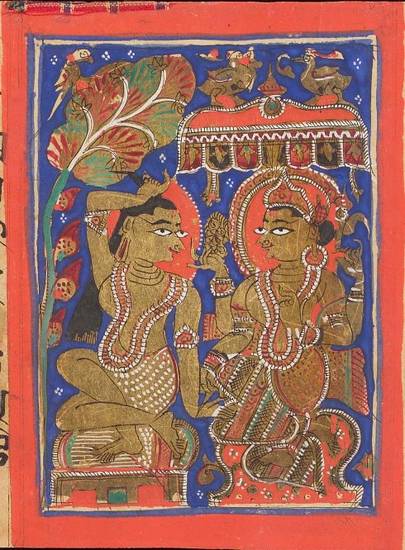
Mahāvīra’s initiation
Image by Wellcome Trust Library © Wellcome Library, London
Considering the central importance of the Jinas in Jainism – as the ultimate source of knowledge, teaching and behaviour – it is not surprising that many festivals focus on events of their lives. Early sources take care in stating where and when these events took place. The specified places determine Jain sacred geography and the precise dates form the basis of the religious calendar, with many festivals commemorating these events. Even today Jains are well aware of such links with the past, which the mendicants regularly recall during the festivals.
Before reaching omniscience, the Jinas were part of the cycle of rebirths. All of their lives showed a similar pattern. In the standard account of their lives, of which Hemacandra in the 12th century can be considered representative, there is a set of five events. Each associated with a precise date of the lunar calendar, these ‘auspicious events’ – pañca-kalyāṇakas – are at the centre of worship:
- conception – cyavana
- birth – janma
- initiation into monastic life – dīkṣā
- enlightenment – kevala-jñāna
- liberation – nirvāṇa or mokṣa.
This standard account is the result of a progressive systematisation in the sources. In earlier sources, such as the Kalpa-sūtra, the five dates are given but only for four Jinas. In another one, the Āvaśyaka-niryukti, the dates of enlightenment and final liberation are the only ones offered, but they are given for all of the 24 Jinas.
Theoretically, then, there is a total of 120 dates – five events for each Jina – if the 24 Jinas from Ṛṣabha to Mahāvīra are taken into account. There are many more if the Jinas of all continents and Jinas of all times are considered. All these dates are potential commemorative festivals. But there are hierarchies, changes and innovations that lead to selections, so that some dates give birth to public celebrations while others do not, although they are considered sacred.
In practice, the main commemorative festivals are:
- Dīvālī – celebrates Mahāvīra’s liberation
- Mahāvīr Jayantī – marks Mahāvīra’s birth
- Maunaikā-daśī – commemorates events relating to several Jinas
- Poṣa-daśamī – honours Pārśva’s birth
- Merutrayo-daśī – dedicated to Ṛṣabha’s final emancipation.
The list of such celebrations is longer if various historical Jain teachers of the remote or recent past are included. But, generally speaking, they do not have the same impact as the festivals given above and are observed by smaller groups.
Festivals of key concepts
Three occasions are good illustrations of the second type of Jain festival. They highlight the significance of certain major concepts in Jain belief and practice.
The Akṣaya-tṛtīyā – ‘Immortal Third’ – celebrates the institution of proper alms-giving. Taking as inspiration an episode in the first Jina’s life, it is celebrated among Śvetāmbaras and Digambaras alike.
True knowledge is an important concept in spiritual progress, which is stressed in festivals among both major sects. Jñāna-pañcamī – ‘Knowledge Fifth’ – is the Śvetāmbara festival while the Śruta-pañcamī – ‘Scripture Fifth’ – is the Digambara equivalent. Both festivals lay particular importance on scriptural knowledge, which is a means of reaching true spiritual knowledge.
Āyambil Olī is a celebration of fasting as an ethical value and of Jain teachers and central concepts. Typically a women’s festival, Āyambil Olī reserves a pivotal role for worship of the siddhacakra.
Local festivals
The final type of Jain festival celebrates local events and so these are not marked by all Jains. The local lay community celebrates events in the neighbourhood temple and in the lives of mendicants in the district.
Most Jains focus on the local temple as the centre of religious life and so many temple events bring about public rejoicing. Frequent examples include the installation of a new image in the ceremony of pratiṣṭhāmahot-sava and the formal opening of a new temple. The Sthānaka-vāsin sect does not believe in image-worship and thus they do not have such festivals, however.
Marking key events in the local community of monks and nuns is a common reason for local festivals. When a new mendicant is initiated, the lay Jains stage major celebrations. Public rituals are part of the initiation process and those who are renouncing the world are honoured like royalty before they undergo dīkṣā. Such celebrations announce to the neighbourhood at large the creation of a new Jain monk or nun with loud music, incense, colourful clothing and processions.
Since Jain mendicants have a wandering life, they are constantly on the move except during the annual rainy season. When a group of monks or nuns arrives in an area to stay for the four months of the monsoon, the local lay Jains rejoice publicly. They also mark the mendicants’ departure at the end of the rainy season with a celebration.
When a monk or nun gains a higher position in the monastic order, the local lay people honour this with public celebrations called nandī-mahot-sava.
Anointing of Bāhubali
One of the most spectacular Jain festivals is a local celebration centred on a holy statue. The anointing of Bāhubali – Mahā-mastakābhiṣeka – commemorates the installation of the colossal statue at Śravaṇa Beḷgoḷa in Karnataka. Taking place every 12 to 14 years, the ceremony and associated festivities draw thousands of pilgrims and sightseers.
Commemorations relating to the Jinas focus on them wherever their images are housed. In this case, the celebrations focus on a specific image in a particular place. Though he is not a Jina, Bāhubali is considered as worthy of reverence as a Jina by many Jains, especially Digambaras. This is because they regard him as the first human being of our cosmic cycle to reach final liberation.
Elements of Jain festivals
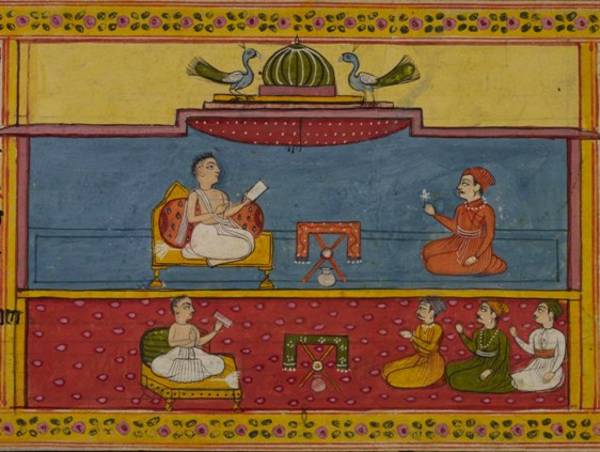
Lay men listen to monks
Image by British Library © CC0 1.0 (Creative Commons Public Domain)
Most Jain festivals combine religious observances, often very severe, with a joyful and colourful atmosphere. All parts of the fourfold community participate and, as festivals usually last a few days, there are times set aside for religious activities for both individuals and groups and for more straightforwardly festive pursuits.
Various ways of communicating the key beliefs and stories are central to festivals. These range from sermons and retellings of stories, images and objects portraying episodes and individuals, and devotional songs.
Many Jain festivals have an important performative dimension that unfolds in different ways. There are two main elements – re-enactment and retelling of the central event, and involvement in family or group-oriented activities. Lay Jains are involved in both re-enactments and retellings of the event that has inspired the festival. They act out the event and form the audience for the re-enactments and the retellings, which mendicants deliver.
Although overseen by ascetics, festivals provide plenty of chances for lay people to become actively involved as well as being audiences and spectators. Such opportunities include performing religious observances, acting, singing, processing and donating. Music has a central role in both routine worship and festivals.
Most elements of Jain festivals combine religious and social aspects, serving to cement both community ties and religiosity.
Religious observances
For the laity, festivals are an opportunity to take on restrictions that are not always observed at other times. The aim is to be temporarily as close as possible to the mendicant’s way of life. The usual religious observances during festivals include:
- dietary restrictions
- temporary celibacy for married Jains
- performing confession and repentance – pratikramaṇa
- singing hymns of praise to the Jinas.
Dietary restrictions
Various kinds of dietary restrictions or fasts are commonly completed during festivals:
- not eating after sunset
- excluding certain kinds of food
- partial fasting, for example taking one meal a day instead of two
- complete fasting, taking only boiled water
- complete fasting for a limited period of time.
Not eating after dark is a basic food rule in theory, but is not practised by all Jains so a festival offers a chance to observe this rule.
Many Jains take a vow to avoid certain foods or types of food. One of the most severe fasts of this kind is āyambil, which is eating very bland food, without any spices.
Partial fasting is often completed over several days. Three-day fasts – aṭṭham – and eight-day fasts – aṭṭhāī– are often observed during Paryuṣaṇ.
Fasting totally for the duration of a festival is probably the most demanding fast to keep. To survive, the fasters drink only boiled water. As there is no danger of its containing minute beings, this is the only acceptable liquid from the religious point of view.
Other devotees may vow to fast completely for a short time, such as a day or so. In this case, they will not take any food or liquid.
Confession
Jain monks and nuns are supposed to complete numerous rituals of confession and repentance – pratikramaṇa – each day. When lay people do this, they are imitating part of a mendicant’s daily routine, which helps them reflect on their conduct and mental attitudes.
Going through numerous confession rituals is a key part of many festivals. Indeed, they are defining elements at the centre of Paryuṣaṇ and Daśa-lakṣaṇa-parvan, which both end with asking for forgiveness.
Passing on religious beliefs
One of the key functions of Jain festivals is to ensure the understanding and survival of religious principles and practices. This is done in several ways, not least in religious observances and the inclusive nature of the festivals. Other methods of transmitting and strengthening belief include preaching, story-telling in various forms, processions, and music and dance.
Involving the whole community, both mendicant and lay, in festivals enhances the concept of the fourfold community in a practical manner. Normally, the most common interactions between lay people and mendicants revolve around alms. During festivals, however, lay men and women and monks and nuns are in closer contact than usual.
The mendicants perform rituals, act as advisers and fully assume their roles as teachers, especially when giving the sermons that feature in the festivals. They also lead the processions when needed.
Lay people hear the lessons and look at visual representations of the sacred teachings. They too help pass on religious beliefs and practices by re-enacting significant episodes and getting involved in the processional and musical elements of the festivals.
Retellings and sermons

Monk and pupils
Image by Chandu Shah © Chandu Shah
Along with sermons, retellings of the central event of the festival are important constituents of Jain celebrations.
Mendicants give sermons at the temple or in the hall in their lodgings – upāśraya. The preachers often base their sermons on the large body of literature known as parva-kathā or vrata-kathā. This is a specific literary genre of stories connected with each festival. The stories are available in all the regional languages Jains use, and are also found in Prakrit or Sanskrit.
Some Śvetāmbara authors have specialised in writing such texts. Examples include Kanakakuśala in the 17th century, Vijayalakṣmī-sūri in the 18th century and Kṣamākalyāṇa in the 19th. Booklets of these stories can be found in specialist Jain shops or at the temples. They generally consist of the story itself and the vidhi – that is, the rules for the religious acts to be performed during the festival and the way to celebrate it.
Of course, mendicants are not necessarily bound by a text in their sermons. Improvised sermons are common and more appreciated by the listeners.
Scriptures
Knowledge of the teachings found in the scriptures is an essential part of spiritual advance for Jains. Therefore sacred texts play a vital role in several Jain festivals, for example:
- the Kalpa-sūtra is publicly elaborated upon and read fully, though quickly, during Paryuṣaṇ
- the Tattvārtha-sūtra is read aloud during the ten days of the Daśa-lakṣaṇa-parvan festival
- holy writings in general feature in certain festivals, namely the Śvetāmbara festival of Jñāna-pañcamī and the Digambara festival of Śruta-pañcamī.
Visual art
During festivals, Jain beliefs and stories are also transmitted through works of visual art. For instance, silver or golden plaques of the auspicious dreams seen by Mahāvīra’s mother are hung from temple ceilings during the celebrations of Mahāvīra’s birth that are part of Mahāvīr Jayantī and Paryuṣaṇ.
Some manuscripts and printed editions of the parva-kathā and vrata-kathā genre associated with festivals contain paintings. Such manuscripts are shown to the congregation gathered in the temples on these occasions (Upadhye 1972: 16). During Paryuṣaṇ, paintings of the Kalpa-sūtra fulfil this role as well.
Re-enactments
A key way in which lay Jains are involved in festivals is the custom of re-enacting the event behind them.
Jain devotees perform as mythical characters in relevant episodes. For example:
- during Mahāvīr Jayantī a couple impersonates the god Śakra and his wife worshipping the new-born Jina
- during the festival of Akṣaya-tṛtīyā the fasting individual – tapasvī – represents the first Jina Ṛṣabha and his family members take the role of Prince Śreyāṃsa.
Among Śvetāmbara Mūrtipūjaks, auctions – bolī – may be used to select the lay men and lay women to play certain characters. Since only a few families are able to outbid the others for roles, it is a way to display their affluence to the wider group. Gaining wealth is respected in the Jain lay community because any voluntary restrictions or renunciations are considered to be harder and thus more meritorious.
Music
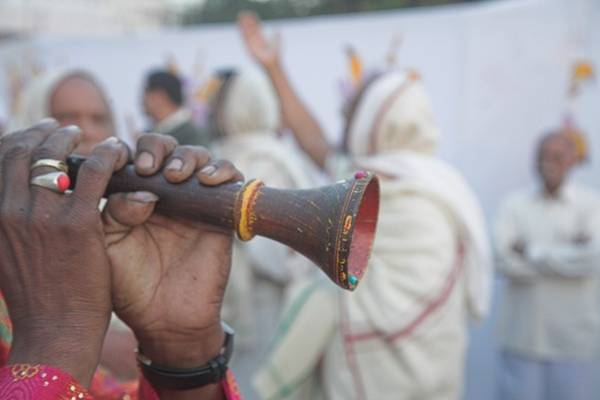
Celebrating initiation
Image by Jayesh Gudka © Jayesh Gudka
In contrast with the apparently unrestrained exuberance of Hindu festivals, Jain festivals are occasions for lay people to act in a way that echoes the austere lifestyle of mendicants for a short while. However, Jain festivals are neither boring nor severe. Asceticism does not prevent a profusion of colours, smells and sounds, while music and hymn-singing are crucial parts of the celebrations. Lay Jains who are not directly involved in the acting element of a festival usually take active roles in the collective singing of hymns or processions, which frequently involve music.
For Jains, singing devotional songs is both a basic religious duty and a social activity. Instrumental music and enthusiastic devotional singing are characteristic of most festival days. Hymns in Jainism are always songs of praise to the Jinas. These are sung by single-sex choirs as part of religious rituals as well as by the whole congregation. Musicians playing instruments usually accompany the singers. There are specific devotional songs for each festival.
These features do not contradict the ultimate goal of spiritual progression since they are regarded as contributing to it. They justify an ‘aesthetic’ approach, taking into account all the sensory factors of the rituals (Glasbrenner 2010).
Processions
One of the most spectacular elements of Jain festivals is the procession – yātrā – also called chariot-procession or car-festival – ratha-yātrā. Statues or pictures of Jinas in a small shrine are placed on top of a chariot that is pulled by hand, elephant or tractor. The chariot is decorated with flowers. The images are sheltered by a parasol and are fanned by people holding fly-whisks, both symbols of royalty. Behind the image troop the lay people, often singing and dancing. The procession goes from one temple to another or from the house of a wealthy lay man to the temple that is the final destination.
These processions are not only admitted but encouraged by śrāvakācāra – the handbooks regulating the life of the laity . As the authors say, they are ‘an external manifestation of the importance and material prosperity of those who profess the Jaina religion’ (Williams 1963: 234) and a way to spread the faith – prabhāvanā – which is a constituent of right belief. They are a sign of the Jain presence in the general social environment.
The final destination of the processions and the main place where a Jain festival is celebrated is generally a local temple dedicated to the Jina at the heart of the event. For Sthānaka-vāsins, who do not have temples, this place is a hall – sthānaka. In cases where a festival is fundamentally connected with one sacred place or tends to be – for example, the anointing of Bāhubali and Akṣaya-tṛtīyā – a full-fledged pilgrimage – tīrtha-yātrā – may be part of the festival. This is organised by leading lay members for the whole group.
Festivals today
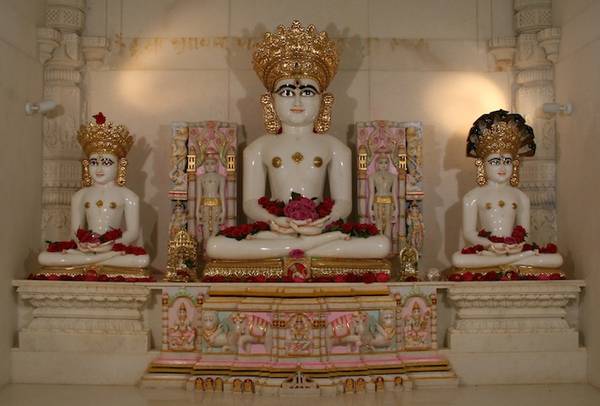
Decorated idols of Māhavīra, Pārśva and Ṛṣabha
Image by Ravin Mehta © Ravin Mehta
Festivals are a way for the Jains to reaffirm their identity as a group and are internal affairs. But there are two exceptions, namely:
- Mahāvīr Jayantī is the only Jain festival to be listed in the official calendar of Indian holidays and has national status
- the celebration of Paryuṣaṇ in Gujarat.
Gujarat is a stronghold of Śvetāmbara Jains and when Paryuṣaṇ comes round each year the Jain communities negotiate with the state government so that slaughterhouses, butchers and fisheries are closed during this ten-day period. In acting like this, the Jains follow the famous example of the 17th-century Mughal Emperor Jahangir. He issued an official proclamation of a similar type at the request of a delegation of Śvetāmbara religious teachers. This practice is known as amāri – literally ‘non-killing’ and therefore ‘protecting’.
Such a ban primarily affects the Muslims who mostly form these professions and it does not go without protest. In 2008 a group of Muslim butchers petitioned the Supreme Court of India, arguing that no one has the right to prevent anybody else from practising his profession. They lost the case. The Supreme Court’s conclusion was that a faith community’s religious sensitivities trump the professional and commercial interests of another, albeit for a short while.
Reading
- Organizing Jainism in India and England
Marcus Banks - Oxford Studies in Social and Cultural Anthropology series; volume 3
Clarendon Press; Oxford, UK; 1992
- Śrī parvakathādi vividha viṣaya saṃgraha
Muni Bhuvanavijaya - Bhinmal, Rajasthan, India; 1980
- ‘Fistfights in the Monastery: Calendars, Conflict and Karma among the Jains’
John E. Cort - Approaches to Jaina Studies: Philosophy, Logic, Ritual and Symbols
edited by N. K. Wagle and Olle Qvarnström
Centre for South Asian Studies, University of Toronto; Toronto, Canada; 1999
- Jains in the World: Religious Values and Ideology in India
John E. Cort - Oxford University Press USA; New York, USA; 2001
- The Jains
Paul Dundas - Library of Religious Beliefs and Practices series; series editor John Hinnels and Ninian Smart; volume 14
Routledge Curzon Press; London, UK; 2002
- ‘A Note on the Heterodox Calendar and a Disputed Reading in the Kālakācāryakathā’
Paul Dundas - Journal of the Pāli Text Society
volume 29
2007
- ‘Festivals’
Jyoti Prasad Jain - Religion and Culture of the Jains
Jñānapīṭha Mūrtidevī granthamālā: English series; volume 6
Bhāratīya Jñānapītha; New Delhi, India; 1975
- Heroic Wives: Rituals, Stories and the Virtues of Jain Wifehood
M. Whitney Kelting - Oxford University Press USA; New York, USA; 2009
- Śrāddhavidhiprakaraṇa
Ratnaśekhara-sūri - Śreṣṭhi-Devacanda-Lālbhāī-Jaina Pustakoddhara Fund series; volume 106
Surat, Gujarat, India; 1960
- Śrī Jainavrata-kathāsaṃgraha: 40 vrata-kathāoṃ kā saṃgraha
Dīpacandajī Varṇī - Surat, Gujarat, India; 1975
- Historical Dictionary of Jainism
Kristi L. Wiley - Historical Dictionaries of Religions, Philosophies, and Movements series; series editor Jon Woronoff; volume 53
Scarecrow Press; Maryland, USA; 2004
- Jaina Yoga: A Survey of the Mediaeval Śrāvakācāras
Robert Williams - London Oriental series; volume XIV
Oxford University Press; London, UK; 1963
Links
- Main Jain festivals
-
The Jain Heritage Centres website provides information about the major Jain festivals.
- Descriptions of main Jain festivals
-
The Jainworld website offers summaries of the principal Jain festivals.
- Major Jain festivals
-
The Victoria and Albert Museum in London provides information about some of the major Jain festivals.
- Mahāvīr Jayantī procession – part two
-
The festival of Mahāvīr Jayantī is often marked with a procession in which images of the 24th Jina Mahāvīra are carried through the streets. This large procession is made up of animals, musicians and singers, dancers and local Jains celebrating the birth of the last Jina. People perform worship in front of the image. Children dressed in white represent monks and nuns while others re-enact scenes associated with Mahāvīra’s birth. Nude Digambara monks stand out in the crowd. This procession took place in March 2010 in Jaipur, Rajasthan and also featured the message of environmental conservation.
Captured in two parts on YouTube, this is the second part. You can also watch the first part.
- Mahāvīr Jayantī procession – part one
-
The festival of Mahāvīr Jayantī is often marked with a procession in which images of the 24th Jina Mahāvīra are carried through the streets. This large procession is made up of animals, singers and musicians, dancers and local Jains celebrating the birth of the last Jina. This procession took place in March 2010 in Jaipur, Rajasthan and also featured the message of environmental conservation.
Captured in two parts on YouTube, this is the first part. You can also watch the second part.
- Digambaras celebrate Mahāvīr Jayanti
-
This 2009 YouTube video shows a Mahāvīr Jayanti celebration in the temple in Indore, Madhya Pradesh. Digambara novice monks carry an idol of Mahāvīra in the centre of a colourful procession. Lay people perform rās-garba dances with sticks. A local lay man and his wife, who ride an elephant in this celebration, play the king and queen of the gods. The annual festival commemorates the birth of the 24th Jina, Mahāvīra.
- Lighting Dīvālī lights
-
The festival of Dīvālī is celebrated by all the major Indian religions, with the Jains commemorating the final liberation of the 24th Jina, Mahāvīra. Called the 'Festival of Lights' from a corruption of the Sanskrit term dīpa, the traditional clay lamp, Dīvālī always features lights on every available surface, arranged both inside and outside buildings, in the streets, around statues and altars. This 2007 Flickr photograph shows people lighting candles in New Delhi, the capital of India.
- Dīvālī lights
-
Dīvālī is known as the 'Festival of Lights', taking its name from a corruption of the Sanskrit term dīpa, the traditional clay lamp. Celebrated by the major Indian religions, Dīvālī always features lights on every available surface, arranged both inside and outside buildings, in the streets, around statues and altars. With different meanings for various religions, the festival commemorates the final liberation of the 24th Jina, Mahāvīra, for Jains. This 2008 Flickr photograph shows dīpas in Kolkata, West Bengal.
- Temple decorated for Dīvālī
-
Jains commemorate the final liberation of the 24th Jina, Mahāvīra, in the festival of Dīvālī in late September or October. At Dīvālī, as in other festivals, statues and temples are lavishly decorated, as shown in this 2007 Flickr photograph of the Katraj temple in Pune, Maharashtra. Lights are festooned everywhere during the 'Festival of Lights', with both electric lighting and traditional clay lamps – dīpas – used. Examples of the ancient auspicious symbol of the svastika, with four dots representing the Jain community or the four states of existence, are clearly seen either side of the temple entrance.
http://www.flickr.com/photos/darvekar/1978597664/in/set-72157603105954957/
- Rangoli of Mahāvīra
-
This rangoli of the 24th Jina, Mahāvīra, was created as part of the 2006 Dīvālī celebrations at the Victoria and Albert Museum in London. Jains commemorate Mahāvīra's final liberation during Dīvālī, which lasts several days. The festival is celebrated by all the major Indian religions, though with different interpretations of the festivities associated with the coming of the new year. Creating rangoli – auspicious patterns and pictures – is common during Indian festivals, as signs of welcome and auspiciousness. Traditionally made of coloured rice or powder, rangoli range from simple shapes to highly intricate designs that take days to complete. This 2006 photo is found on the Flickr website.
- Decorated idol of Mahāvīra surrounded by lights
-
One of the most important Jain festivals, Dīvālī takes place over several days in late September or October. Jains commemorate the final liberation of the 24th Jina, Mahāvīra. At Dīvālī, as in other festivals, statues and temples are lavishly decorated, as shown in this 2007 Flickr photograph of the statue of Mahāvīra in the Katraj temple in Pune, Maharashtra. The lights surrounding the image indicate why the festival is known as the 'Festival of Lights'.
- Anointing a Jina statue
-
A statue of a Jina is ceremonially anointed during the festival of Dīvālī, the 'Festival of Lights' which marks the new year. For Jains the main celebration at Dīvālī is the commemoration of the liberation of the 24th Jina, Mahāvīra. A ‘head-anointing ceremony’ – mastakābhiṣeka – is a rite performed for any Jain image. Sanctified fluids are poured over the head of the statue, accompanied by a mantra or hymn. The sacred bath is at the centre of all Jain image rituals and can be performed daily in the morning ceremony or during festivals and pilgrimages. This photo on Flickr was taken in Jodhpur, Rajasthan in October 2009.
- Re-enactment of the story of Candanabālā
-
This slideshow displays the re-enactment of the story of Candanabālā, who offered Mahāvīra appropriate food to break his fast. Sold into slavery, the beautiful princess has her lovely hair chopped off and is starved for three days. Even so, her first act when released is to offer alms to a passing mendicant. He is Mahāvīra, who becomes the 24th Jina, and he has been fasting for nearly six months. Candanabālā’s act of selfless charity despite her suffering causes her hair to be restored and her true identity revealed. The story of this virtuous woman – one of the soḷa satī – emphasises the importance of offering alms correctly. Acting out such stories is an important part of many Jain festivals. This re-enactment on YouTube was performed by Śvetāmbara Jains in Melbourne, Australia during the festival of Paryuṣaṇ in 2010.
- Procession of Mahāvīra idol
-
This 2009 YouTube video shows the procession of a small golden idol of Mahāvīra – rathayātrā – through the streets of New Delhi. The procession takes place during the Digambara festival of Daśa-lakṣaṇa-parvan. The men in orange, some of whom are also crowned, are the prominent lay men who have won the privilege of accompanying the statue in the procession. They put the statue in an ornate shrine on a platform set on a tractor with false horses attached. Before the procession begins, Jain lay women move trays of fire in circles – āratī – offering pūja or worship to the idol. Lay people dance in the procession around the idol, which is fanned by fly-whisks, a sign of high status. Many of the dancers wave bright plastic objects, which are modern equivalents of traditional fly-whisks. The women dressed in orange are the wives of the prominent lay men on the tractor. A model of Bāhubali with vines creeping up his legs is also fanned. Small children ride on the shrine, which is hung with a Jain flag at the back, while musicians and models form part of the procession. Two fully fledged monks take part, accompanied by novice monks in white. At the end of the procession the idol is taken into the temple, placed in front of a large Jina image and given a sacred bath. Food is provided for the participants afterwards. All along, there are various songs or prayers. In the first part, the Pañca-namaskāra-mantra is sung to various tunes, then come hymns in Hindi. For instance, one of them says: ‘Listen to the voice of the Jinas’.
- Navapada mahāyantra
-
The siddhacakra or navapada mahāyantra is the most popular Jain yantra, believed to be highly auspicious. It is a mystical diagram representing the major parts of the path to liberation from the cycle of rebirth. With a key role in worship rituals, the siddhacakra has a central position in the Āyambil Oḷī festival. The picture is found on the HereNow4U website.
- Śruta-pañcamī – part 1
-
Some features of the annual Digambara festival of knowledge – Śruta-pañcamī – are demonstrated in this YouTube video, such as the worship ritual and the procession of holy texts. Temple rites include the ritual anointment of freestanding metal plaques representing holy texts and idols, accompanied by jangling percussion. The main part of the ritual shown in this video centres around the worship of the śruta-skandha-yantra, a plaque made of brass in the form of a tree, which represents the kinds of scriptures Digambaras recognise. Carried in procession, the sacred books are garlanded with flowers and flanked by attendants using fly-whisks, which indicate the princely status of the artefacts, while devotees kneel before a naked monk and touch his feet. The Ṣaṭkhaṇḍāgama, the main authoritative source of Digambara teachings, is the book worshipped here.
This three-part YouTube video records the festival at Mudalur, Tamil Nadu in India, held over 28th and 29th May 2009. This is the first part and you can watch the second part at: http://www.youtube.com/watch?v=M-I9AYjIcAc
- Śruta-pañcamī – part 2
-
The procession of holy texts in the annual Digambara festival of knowledge – Śruta-pañcamī – is the main subject of this YouTube video. As the centre of festivities, the sacred books are decorated with flower garlands. They are placed on a model elephant, protected from the sun by a canopy and fanned with fly-whisks, all symbols of royalty. The Jain flag is waved in front. Lay Jains, many dressed in orange – the colour of spirituality in India – take part in the noisy procession. Some carry the metal sculptures of the 12 dreams of a Jina’s birth. A nude monk, holding his peacock-feather broom, and white-clad nuns also participate. The procession ends with a display of holy books, the reflection of which is ritually anointed, and a rite of worship in which the auspicious symbol of the svastika can be clearly seen.
This three-part YouTube video records the festival at Mudalur, Tamil Nadu in India, held over 28th and 29th May 2009. This is the second part and you can watch the last part at: http://www.youtube.com/watch?v=zR21K-vcp5U
- Paryuṣaṇ recipes
-
Recipes suitable for cooking during the Śvetāmbara festival of Paryuṣaṇ from the ramkicooks blog. During this annual festival of eight days, observant Jains tend to follow stricter than normal rules regarding food. Most families give up fresh vegetables, eating only grains, pulses and dairy produce. Taking additional vows to fast completely or partly for any given day of the festival, particularly the first and last days, is common.
- Paryuṣaṇ in the United States
-
The Pluralism Project at Harvard offers a short essay on the festival of Paryuṣaṇ, called 'Paryushan and the Festival of Forgiveness'. It focuses on contemporary Jainism in the United States.
https://pluralism.org/paryushana-and-the-festival-of-forgiveness
- Svastika during Paryuṣaṇ
-
A svastika formed out of traditional clay lamps – dīpas in Sanskrit – is arranged on the petal-strewn floor of a temple during the festival of Paryuṣaṇ. The svastika is an ancient symbol of good luck and is frequently found in Jain temples, on religious equipment and on books, clothing and so on. The four dots among the arms of the svastika represent either the four states of existence or the parts of the fourfold community. Lasting eight days in late August or early September, Paryuṣaṇ is the most important Śvetāmbara Jain festival. This photograph on Flickr was taken in 2007.
- Supreme Court upholds a Paryuṣaṇ ban
-
Details of the Supreme Court of India's 2008 ruling to uphold the state government of Gujarat's ban on the operation of slaughterhouses and butchers during the Jain festival of Paryuṣaṇ. The CAclubindia.com provides this information in its Judiciary section.
- Report of Supreme Court decision to uphold Paryuṣaṇ ban
-
IBN Live news website reports the 2008 ruling of the Supreme Court of India to uphold the decision of the state government of Gujarat to ban the operation of slaughterhouses, butchers and fisheries during the festival of Paryuṣaṇ. The 2008 article includes a video of the television news report, which features a phone interview with the legal correspondent in New Delhi. He explains the history of the legal case and possible wider applications of the ruling throughout India.
http://ibnlive.in.com/news/gujarat-meat-eaters-can-abstain-out-of-respect-sc/61275-3.html
- Mahāvīr Janam Divas celebration
-
This YouTube slideshow of the celebrations of Paryuṣaṇ in Melbourne, Australia in 2010 illustrates some of the features of the eight-day long festival. Sculptures of the 14 auspicious dreams experienced by Mahāvīra’s mother are suspended from the ceiling on the fifth day of Paryuṣaṇ – Mahāvīr Janam Divas, which celebrates the birth of Mahāvīra, the 24th Jina. The sculptures are venerated in turn by all the festival participants, sometimes by being held to the crown of the head, seat of spirituality in Indian culture. Then auctions – bolī – are held to decide who should perform various ceremonies. The most important and expensive auction is over the right to take home the image of the infant Mahāvīra for the last three days of the festival. Everyone can rock the cradle holding the idol of the baby Jina, which takes pride of place in the display.
- Kārttika Pūrṇimā – part 1
-
The festival of Kārttika Pūrṇimā marks the end of the rainy season and the start of ordinary activities, which stop during the monsoon period. Men chant and clap loudly before the idol of a Jina from the temple is borne in procession – ratha-yātrā.
This two-part YouTube video records the 2010 Kārttika Pūrṇimā festival celebrated in Kolkata in West Bengal by Śvetāmbara Jains. This is the first part and you can watch the second part.
- Kārttika Pūrṇimā – part 2
-
The Kārttika Pūrṇimā festival celebrates the end of the rainy season, when ordinary life can begin again. The image of a Jina from the temple is carried in procession through the streets – ratha-yātrā – while people wave fly-whisks before it, a symbol of royalty. People throw rice grains or sacred powder on to the idol. Though common in many Jain festivals, the idol procession is often a key part of Kārttika Pūrṇimā.
This two-part YouTube video records the 2010 Kārttika Pūrṇimā festival in Kolkata in West Bengal, as celebrated by Śvetāmbara Jains. This is the second part and you can watch the first part.
- Worship at Shravana Belgola
-
This short 2009 video films a worship ceremony – pūja – at the pilgrimage site of Shravana Belgola in Karnataka. The temple attendants perform the daily ritual bath – mastakābhiṣeka – on the small metal idol at the bottom of the 18-metre-high statue of Bāhubali, also called Gommaṭeśvara or ‘Lord of Gommaṭa. They trickle water on to the feet of the stone colossus and offer it to worshippers because the water is believed to have special properties after it has been used in the ceremony. The grand version of the rite – Mahā-mastakābhiṣeka or ‘Great head-anointing ceremony’ – is one of the most spectacular Jain festivals and takes place every 12 years, drawing thousands of pilgrims and sightseers. ifredpr uploaded this video to YouTube in 2011.
- Head anointing ceremony
-
The Huntington Archive at Ohio State University provides a photograph of devotees anointing a smaller image at the foot of the large statue of Bāhubali at Shravana Belgola in Karnataka. In this 2001 photo, the pilgrims are performing a ‘head-anointing ceremony’ – mastakābhiṣeka – of a small image of Bāhubali. This rite can be carried out for any Jain image and involves pouring consecrated liquids over the head, accompanied by a mantra or hymn. The sacred bath is at the centre of all Jain image rituals and can be performed daily in the morning ceremony or during festivals and pilgrimages.
http://huntington.wmc.ohio-state.edu/public/index.cfm?fuseaction=showThisDetail&ObjectID=30021938
- Poṣa-daśamī – part 1
-
The Poṣa-daśamī festival celebrates the birth of the 23rd Jina, Pārśvanātha or Lord Pārśva. Held in late December or early January in the Western calendar, Poṣa-daśamī is also known as Pārśvanātha-jayantī. Typically of many Jain festivals, an idol from a local temple is the centre of a procession through the streets – ratha-yātrā. The procession includes decorated animals, musicians, lay Jains and white-clad nuns. The Jina image is hung with bright flower garlands and is fanned with fly-whisks, symbolic of royalty. Lay Jains dance, sing and clap as the statue is brought into the temple at the end of the procession.
This two-part YouTube video records the 2010 Poṣa-daśamī festival in Jaipur, Rajasthan as celebrated by Śvetāmbara Jains. This is the first part .
http://www.youtube.com/watch?v=YihWayx7NKQ
Watch the second part here https://www.youtube.com/watch?v=UddsDpAwYAY
- Poṣa-daśamī – part 2
-
Commemorating the birth of the 23rd Jina, Pārśvanātha or Lord Pārśva, the Poṣa-daśamī festival is also known as Pārśvanātha-jayantī. It is celebrated in late December or early January in the Western calendar. Following a street procession – ratha-yātrā – the garlanded statue of Pārśva is brought into the local temple, while a conch is blown and a bell rung. The local community gathers around it and sings hymns in celebration. Chanting, they move a tray of fire in circles, offering pūja or worship to the statue. All the other images of Jinas in the temple are also decorated with flowers.
This two-part YouTube video records the 2010 Poṣa-daśamī festival in Jaipur, Rajasthan as celebrated by Śvetāmbara Jains. This is the last part.
http://www.youtube.com/watch?v=vXsnBlBDOHk
https://www.youtube.com/watch?v=UddsDpAwYAY
- +
- aAbhavya
- aAbhinandana
- aAbhiṣeka
- aĀcāra
- aĀcārāṅga-sūtra
- aĀcārya
- aAchalbhrata
- aAḍhāī-dvīpa
- aAdharma
- aAdho-loka
- aAdhyayana
- aAdvaita Vedānta
- aĀgama
- aAghātīya
- aAghātīya-karman
- aAgnibhuti
- aAgra
- aĀhāra
- aAhiṃsā
- aAhimsa Day
- aAjita
- aAjīva
- aAkampit
- aĀkāśa
- aAkbar the Great
- aAkṣaya-tṛtīyā
- aAlauddin Khalji
- aAlbert Einstein
- aAllah
- aAlms
- aĀlocanā
- aAloka-ākāśa
- aAmāri
- aAmbikā or Kūṣmāṇḍinī
- aAnagāra
- aAnanta
- aAnarthadaṇḍa
- aAnaśana
- aAnekānta-vāda
- aAṅga
- aAniconism
- aAnojjā
- aAntarāla
- aAntarāya-karma
- aAṇu
- aAṇu-vrata
- aAnukampā
- aAnuprekṣā
- aAnusvāra
- aApabhraṃśa
- aAparigraha
- aAra
- aĀrambha
- aĀrambhaja
- aĀratī
- aArdhamāgadhī Prākrit
- aArhaṃ
- aArhat
- aArśana-āvaraṇīya-karma
- aĀrta-dhyāna
- aĀryikā
- aĀryikā Jñānamati
- aĀśātanā
- aĀścarya
- aAscetic
- aAsceticism
- aAshram
- aAspiration
- aĀsrava
- aAṣṭa-maṅgala
- aAṣṭāpada
- aAstikāya
- aAstrolabe
- aAsura
- aAtheism
- aAticāra
- aAtiśayakṣetra
- aAtithisaṃvibhāgavrata
- aĀtma-vāda
- aĀtman
- aAuṃ
- aAurangzeb
- aAuspicious
- aAusterity
- aAvadhāna
- aAvadhi-jñāna
- aĀvaraṇī-yakarman
- aAvasarpiṇī
- aAvatāra
- aAvidyā
- aAxiom
- aĀyāga-paṭa
- aĀyambil
- aĀyu-karma
- aĀyurveda
- bBabur
- bBāhubali
- bBaladeva
- bBālāvabodha
- bBandha
- bBasadi
- bBazaar
- bBhadrankarvijay
- bBhagavant
- bBhaktāmara-stotra
- bBhakti
- bBhale
- bBharata
- bBhāṣā
- bBhāṣya
- bBhaṭṭāraka
- bBhāva
- bBhāva-pūjā
- bBhāvanā
- bBhavana-vāsin
- bBhavya
- bBhavyatva
- bBhaya
- bBhoga-bhūmi
- bBhogopabhoga
- bBodhi
- bBollywood
- bBrahmā
- bBrahma-deva
- bBrahmacārī
- bBrāhmaṇa
- bBraj Bhāṣā
- bBright fortnight
- bBritish Raj
- bBuddha
- bBuddhi-sagar
- bBuddhism
- bBuddhist
- cCaitya
- cCaityavāsin
- cCakravartin
- cCakreśvarī
- cCāmara
- cCandanā
- cCandragupta
- cCandraprabha
- cCanon
- cCāritra
- cCāritramohanīya-karman
- cCarũrī
- cCaste
- cCaturvidha-saṅgha
- cCaturviṃśati-stava
- cCāturyāma
- cCE
- cCelibacy
- cCha
- cChadmastha
- cChastity
- cCheda-sūtra
- cChristian
- cChristianity
- cClergy
- cCloning
- cColophon
- cCommentary
- cConch
- cConfession
- cCongregation
- cConsecration
- cCosmology
- cCremation
- cCrore
- cCult
- cCūrṇi
- dDādā-guru
- dDalit
- dDāna
- dDaṇḍa
- dDark fortnight
- dDarśana
- dDarśanamohanī-yakarman
- dDaśa-lakṣaṇa-parvan
- dDeity
- dDelhi Sultanate
- dDerāsar
- dDeśāvakāśika-vrata
- dDetachment
- dDevanāgarī
- dDevānandā
- dDevarddhi-gani
- dDevotee
- dDhamal
- dDhanuṣ
- dDhāra
- dDharma
- dDharma-dhyāna
- dDharma-sāgara
- dDharmastikaya
- dDhātakīkhaṇḍa
- dDholak
- dDhyāna
- dDiaspora
- dDig-vrata
- dDigambara
- dDīkṣā
- dDisciple
- dDīvālī
- dDivya-dhvani
- dDNA
- dDoctrine
- dDogma
- dDonor
- dDoṣa
- dDravya
- dDravya-pūjā
- dDrone
- dDuṣamā
- dDuṣamā-duṣamā
- dDuṣamā-suṣamā
- dDveṣa
- dDvīpa
- eEast India Company
- eEightfold Path
- eEkānta-vāda
- eEkendriya
- eElder
- eElders
- eEschatology
- eEtc up to
- fFarmān
- fFast
- fFatehpur Sikri
- fFestival
- fFestschrift
- fFiruz Shah
- fFly-Whisks
- fFolio
- fFour Noble Truths
- gGaccha
- gGaṇa
- gGaṇadhara
- gGanadharavada
- gGaṇeśa
- gGaṇin
- gGarba
- gGarbha
- gGarbha-gṛha
- gGaruḍa
- gGati
- gGene
- gGenomics
- gGhātī-yakarman
- gGhātīya
- gGhaznavid
- gGhiyasuddin Tughlaq
- gGhurid
- gGloss
- gGotra-karma
- gGujarāt
- gGujarati
- gGuṇa
- gGuṇa-sthāna
- gGuṇa-vrata
- gGupti
- gGuru
- gGuruṇī
- hHagiography
- hHajj
- hHaṃsa
- hHaribhadra
- hHariṇaigameṣin
- hHasta
- hHeresy
- hHiṃsā
- hHindi
- hHindu
- hHinduism
- hHīravijaya
- hHoroscope
- hHrīṃ
- hHumayun
- hHymn
- iIconoclasm
- iIconography
- iIdol
- iIndian Independence
- iIndology
- iIndra
- iIndrabhūti Gautama
- iIndriya
- iInitiation
- iIntercession
- iInvocation
- iIQ
- iIslam
- iIslamicate
- iIṣṭadevatā
- iĪśvara
- jJagat
- jJahangir
- jJain
- jJaina Devanāgarī
- jJaina Śaurasenī
- jJaina-dharma
- jJainaśāsana
- jJainness
- jJaisalmer
- jJamāli
- jJambū-dvīpa
- jJames Burgess
- jJanma
- jJanma-kalyāṇa
- jJarā
- jJāti
- jJina
- jJina-āgama
- jJina-bhavana
- jJina-bimba
- jJina-mātā
- jJinacandra-sūri
- jJinadatta
- jJinaprabha
- jJīva
- jJñāna
- jJñāna-āvaraṇīya-karma
- jJñāna-āvarṇiya
- jJñānsundar
- jJyotiṣka
- kKāla
- kKālakācārya-kathā
- kKālidāsa
- kKalpa-sūtra
- kKalpa-vṛkṣa
- kKalyāṇaka
- kKalyanvijay
- kKamaṇḍalu
- kKamaṭha
- kKarma
- kKarma-bhūmi
- kKarma-grantha
- kKarma-prakṛti
- kKarma-vāda
- kKarmon
- kKarnataka
- kKaṣāya
- kKathā
- kKāvya
- kKāya
- kKāyotsarga
- kKeśa-loca
- kKetu
- kKevala-jñāna
- kKevalin
- kKhalji
- kKharatara-gaccha
- kKnowledge
- kKriyā
- kKriyā-vāda
- kKṛṣṇa
- kKṣamā-śramaṇa
- kKṣapakaśreṇi
- kKṣatriya
- kKṣullaka
- kKulakara
- kKundakunda
- kKunthu
- lLabdhi
- lLaity
- lLakh
- lLāñchana
- lLands of Action
- lLaukāntika
- lLavaṇa-samudra
- lLeśyā
- lLiṅga
- lLinguistics
- lLoka
- lLoka-ākāśa
- lLoka-puruṣa
- lLoka-vāda
- lLotus
- lLotus lake
- mMadhya-loka
- mMahā-videha
- mMahā-vrata
- mMahābhārata
- mMahāmastakābhiṣeka
- mMāhārāṣṭra
- mMāhārāṣṭrī Prākrit
- mMahattarā Yākinī
- mMahāvīr Jayantī
- mMahāvīra
- mMakāra
- mMakkhali Gośāla
- mMalli
- mMāna-stambha
- mManaḥ-paryāya-jñāna
- mMaṇḍala
- mMaṇḍapa
- mMandit
- mMaṅgala
- mMantra
- mMantras
- mManuṣya-loka
- mMarāṭhī
- mMārgaṇā
- mMartyr
- mMarudevī
- mMaṭha
- mMati-jñāna
- mMauryaputra
- mMecca
- mMendicant lineage
- mMetarya
- mMiracle
- mMithyādṛṣṭi
- mMohandas Gandhi
- mMohanīya-karma
- mMokṣa
- mMonastic order
- mMonasticism
- mMonk
- mMonotheism
- mMosque
- mMount Meru
- mMount Sammeta
- mMṛgāvatī
- mMughal
- mMuhammad
- mMuhammad bin Tughlaq
- mMuhpattī
- mMūla-sūtra
- mMūlaguṇa
- mMumbaī
- mMuni
- mMunisuvrata
- mMurad Bakhsh
- mMūrti-pūjaka
- mMuslim
- mMysticism
- nNābhi
- nNāga-kal
- nNāgapurīya Tapā-gaccha
- nNāgarī
- nNāma-karma
- nNamaskāra-mantra
- nNami
- nNandīśvara-dvīpa
- nNandivardhana
- nNandyāvarta
- nNāraka
- nNāraki
- nNasalisation
- nNātha
- nNavrātrī
- nNaya-vāda
- nNemi
- nNidāna
- nniggaṃthāṇa vā 2
- nniggaṃtho vā 2
- nNigoda
- nNihnava
- nNikṣepa
- nNirgrantha
- nNirjarā
- nNirvāṇa
- nNiryukti
- nNiṣidhi
- nNitya
- nNiyati
- nNo-kaṣāya
- nNudity
- nNun
- oOcean of milk
- oOmniscience
- oOrdination
- ppa°
- pPadmaprabha
- pPadmāsana
- pPadmāvatī
- pPādukā
- pPalanquin
- pPalette
- pPañca-muṣṭi
- pPāṇḍava
- pPaṇḍit
- pPandit Dalsukh D. Malvania
- pPandit Sukhlalji
- pPāṇipātra
- pPāpa
- pParamātman
- pParameṣṭhin
- pPāraṇā
- pParigraha
- pPariṇāma
- pParīṣaha
- pParokṣa
- pPārśva
- pPārśvanātha
- pParyāya
- pParyuṣaṇ
- pPaṭa
- pPatan
- pPātra
- pPenance
- pPersian
- pPhala
- pPhilology
- pPicchikā
- pPilgrimage
- pPīr
- pPolymath
- pPoṣadha
- pPossession
- pPothī
- pPrabhas
- pPradakṣiṇā
- pPradeśa
- pPrākāra
- pPrakīrṇaka-sūtra
- pPrākrit
- pPramāda
- pPramukhā
- pPrati-vāsudeva
- pPratikramaṇa
- pPratimā
- pPratiṣṭhā
- pPratyākhyāna
- pPratyakṣa
- pPravacana
- pPrāyaścitta
- pPrayer
- pPre-modern
- pPreach
- pPredestination
- pProtestant
- pProvenance
- pPudgala
- pPūjā
- pPujārī
- pPukharavara-dvīpa
- pPuṇya
- pPūrva
- pPuṣkara-dvīpa
- pPuṣpadanta
- pPyre
- qQur’an
- rRāga
- rRāhu
- rRainy season
- rRajasthan
- rRajasthani
- rRājimatī
- rRajoharaṇa
- rRajput
- rRāma
- rRāmāyaṇa
- rRangoli
- rRās-garbā
- rRasa
- rRathanemi
- rRatna-traya
- rRātri-bhojana
- rRaudra-dhyāna
- rRecto
- rRelic
- rRenunciation
- rRetroflex
- rRevatī
- %Ṛg-veda
- rRite
- rRosary
- %Ṛṣabha
- %Ṛṣabhanātha
- rRupee
- sSaciyā Mātā
- sSādhu
- sSādhvī
- sSāgāra
- sSaint
- sŚaivaism
- sŚaka-saṃvat
- sSallekhanā
- sŚalya
- sSamacatuṣṭha
- sSamādhimaraṇa
- sSamaṇi
- sSāmarambha
- sSamavasaraṇa
- sSāmāyika
- sSaṃbhava
- sSamiti
- sSaṃjñā
- sSaṃkalpaja
- sSaṃsāra
- sSamudghāta
- sSaṃvara
- sSaṃvega
- sSamyak-cāritra
- sSamyak-darśana
- sSamyak-jñāna
- sSamyaktva
- sSaṃyama
- sSanctuary
- sSandalwood
- sSaṇgha
- sSanskrit
- sSant
- sŚānti
- sSapta-bhaṅgi-naya
- sSārambha
- sSarasvatī
- sSarvajña
- sSāsan-devi
- sŚāsana-devatā
- sŚāstra
- %Ṣaṭ-jīvanikāya
- sSatī
- sSatīmātā
- sSatya
- sSchism
- sScribe
- sScripture
- sSect
- sSecularism
- sŚenāī
- sSermon
- sŚeṣavatī
- sSevā
- sSeven fields of donation
- sShah Jahan
- sShantidas Jhaveri
- sShrine
- sSiddha
- sSiddha-śilā
- sSiddhacakra or Navadevatā
- sSiddhānta
- sSiddhārtha
- sSiddhi
- sSikh
- sSikhism
- sŚikṣā-vrata
- sŚīla
- sSin
- sSindh
- sŚītala
- sŚiva
- sSkandha
- sSomanatha
- sŚraddhā
- sŚramaṇa
- sŚrāvaka
- sŚrāvakācāra
- sŚrāvikā
- sŚreyāṃsa
- sŚrī
- sŚrīvatsa
- sŚruta-jñāna
- sŚruta-pañcamī
- sSthānaka-vāsin
- sSthāpanācārya
- sSthāvara
- sSthavira
- sSthiti
- sStrīmukti
- sStūpa
- sSubcontinent
- sSudarshana
- sŚuddhi
- sSudharma
- sŚūdra
- sSufism
- sSukha
- sŚukla-dhyāna
- sSulasā
- sSultan
- sSumati
- sSundarśrī
- sSupārśva
- sSūri
- sSuṣamā
- sSuṣamā-duṣamā
- sSuṣamā-suṣamā
- sSūtra
- sSuyam me ausam! Tenam bhagavaya evamakkhayam
- sSvādhyāya
- sSvāhā
- sSvastika
- sŚvetāmbara
- sŚvetāmbara Terāpanthin
- sŚvetāmbaras
- sSwan
- sSyād-vāda
- tTabla
- tTantra
- tTapā-gaccha
- tTapas
- tTāraṇ Svāmī Panth
- tTattva
- tTattvārtha-sūtra
- tTemple
- tTemple-city
- tThe Enlightenment
- tTheology
- tThree worlds
- %Ṭīkā
- tTilaka
- tTīrtha
- tTīrthaṃkaranāma-karman
- tTīrthankara
- tTransliteration
- tTrasa
- tTrasa-nāḍī
- tTriśalā
- tTriṣaṣṭi-śalākā-puruṣa-caritra
- tTti bemi
- tTughlaq
- tTunk
- uUdumbara
- uUniversal History
- uUpādhyāya
- uUpāṅga
- uUpaniṣads
- uUpāsaka
- uUpasarga
- uUpāśraya
- uŪrdhva-loka
- uUtsarpiṇī
- uUttarādhyayana-sūtra
- vVāhana
- vVaimānika
- vVairāgya
- vVaiṣṇava
- vVaiśramaṇa
- vVaiśya
- vValabhī
- vVanaspatikāya
- vVandana
- vVaṇik
- vVarṇa
- vVāsudeva
- vVāsupūjya
- vVayubhūti
- vVeda
- vVedanīya-karma
- vVegetarianism
- vVehicle
- vVernacular
- vVerso
- vVidyā
- vVidyā-devī
- vVihāra
- vVijñapti-patra
- vVikrama-saṃvat
- vVikṛti
- vVimala
- vVinaya
- vVipāka
- vVirji Vora
- vVirodhaja
- vVīrya
- vVisarga
- vViṣṇu
- vVītarāga
- vVizier
- vVotive
- vVow
- vVrata
- vVS
- vVyakta
- vVyantara
- vVyasana
- yYakṣa
- yYakṣī
- yYantra
- yYaśoda
- yYaśovijaya
- yYati
- yYātrā
- yYoga
- yYoginī
- yYojana



